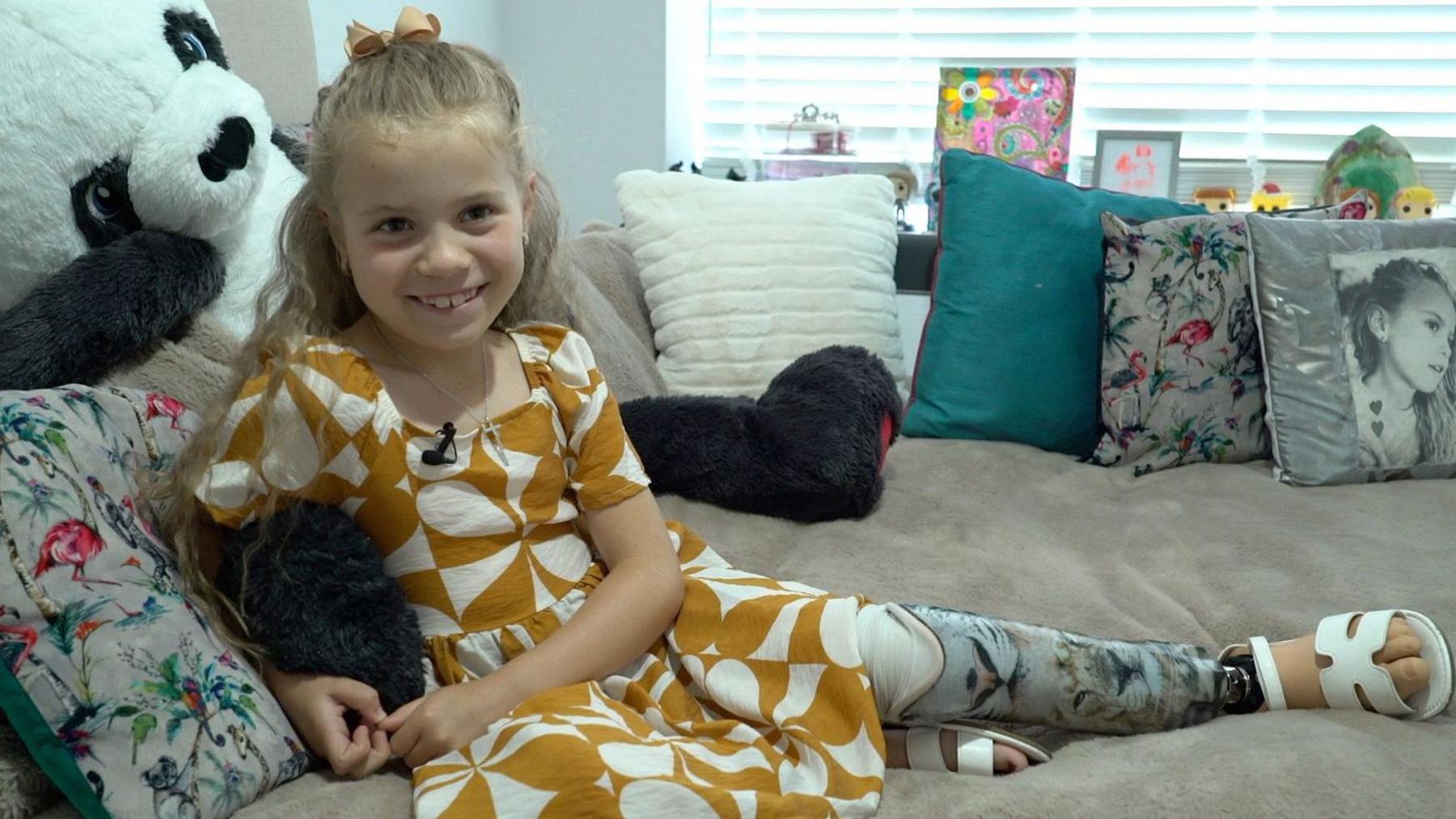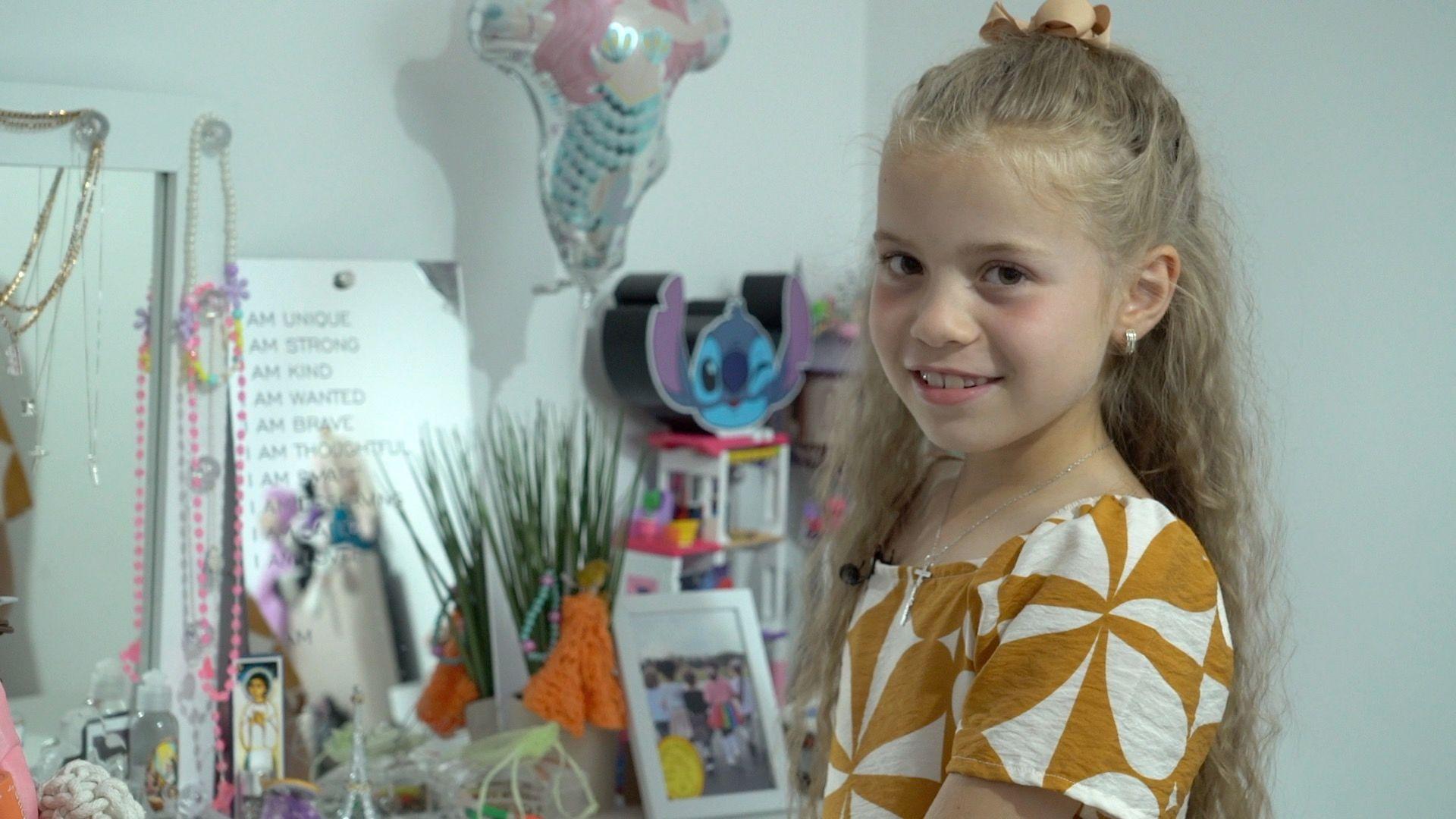'Warrior' girl, 7, showcases life after amputation

River-Lucia was born with fibular hemimelia but is now determined to show others she is still able to have an active life.
- Published
Seven year old River-Lucia is running around the garden of her Cheadle home, dashing up the steps of a slide and coming down the other side again and again.
Mum Leia watches proudly. She regularly films her daughter for their Instagram page, rushing up and down stairs, bouncing on trampolines, paddling in the sea.
On Instagram River-Lucia is the fibular hemimelia warrior - the condition which a year ago led to her left foot being removed.
Ever since, she and her mum have been trying to show others in a similar situation that life, although challenging, can be active and fun.
Fibular hemimelia means one of the two bones in the lower leg, the fibula, is either shorter than normal or missing altogether, causing one leg to be shorter than the other.
Children are born with the condition – in River-Lucia's case, Leia was told during her 20 week scan.
"In this world we are all born different. We all look different," said Leia
She added: "Parents might find it hard to understand and think that the child's going to be treated different or not able to fit in a mainstream school.
"They can and looking at River-Lucia's page you can see she's just normal like any other kid. She's just doing what they do."

River-Lucia and her mum document her journey through their Instagram account
In Greater Manchester parents like Leia are usually referred to the Specialised Ability Centre in Wythenshawe before their child is even born.
It is one of the biggest centres in the country offering both prosthetic (artificial) limbs and external support for existing limbs like built up shoes and splints.
Although most of their patients are adults, the centre does see around 150 children a year, who will stay within their services for the rest of their lives.
Lara Littler, centre manager, said: "We see patients at pre-natal, we see expectant mothers…and then right after the child is born they will be seen by us and we will support that family through the emotional side, the physical side, the development aspects, all the way through."
Staff also talk over the different options for each patient.
In River-Lucia's case, the increasing difference in length could only be treated by multiple leg lengthening surgeries, which involve wearing an external cage for months and can lead to serious complications, or an amputation.
"It was the most difficult decision of our lives," said Leia.
"We could have done it earlier when she was a baby but we held back as we wanted to see how her foot would grow"
"We waited until she was at an age to understand it all, showed her pictures, introduced her to other children…and when we showed River-Lucia the two options, she said "amputation" straight away"
Last July, when she was six-years-old, River-Lucia had her foot removed in a procedure called a Syme amputation.
"It was such a shock. You can prepare yourself all you like but until you're actually there, it was all questions going on in my head, I couldn't sleep, it was 'are we making the right decision? are we going to regret this?'" said Leia.
Shannon Hughes is a prosthetist, a specialist in all aspects of prosthetic limbs, who often works with children. She says anxiety over children undergoing amputation can be overwhelming for all concerned
"It's really important that you involve the child and let them know that they get to make decisions too, but often you're working alongside the whole family, " she said.
"I think there's often a lot more anxiety around children….not knowing the future is kind of scary for most parents, but if you don't know anyone else who has a limb absence like your child then it's hard to know what the future might look like".
Leia said, although there have been challenges, her own daughter's limb amputation has been transformational – for the better. Her prosthetic limb has allowed her to be active in a way that external supports, like built up shoes, could not.
"You just saw her character come out…..She's got so much more confidence, she's not at my side anymore, she's not needing me for help. She must just feel so much more confident in this leg"
Leia now hopes their Instagram account will help other families dealing with the news that a child might have to lose a limb.
When asked what her favourite things are, River Lucia says: "Swimming, climbing, riding my bike, and running".
Her prosthetic limb is covered with pictures of lions, for courage. Her bedroom, like much of the house, is filled with affirmative posters and ornaments. Many of her toys and dolls wear a prosthesis.
"We do have struggles at home getting from A-B and sometimes we do need the wheelchair. But eight times out of 10 she's doing what other kids can do," Leia said.
"It feels good because we know we've made the right decision….She's just giving it her all. Everything she's doing, she's just giving it her all".
Get in touch
Tell us which stories we should cover in Greater Manchester
Listen to the best of BBC Radio Manchester on Sounds and follow BBC Manchester on Facebook, external, X, external, and Instagram, external. You can also send story ideas via Whatsapp to 0808 100 2230.